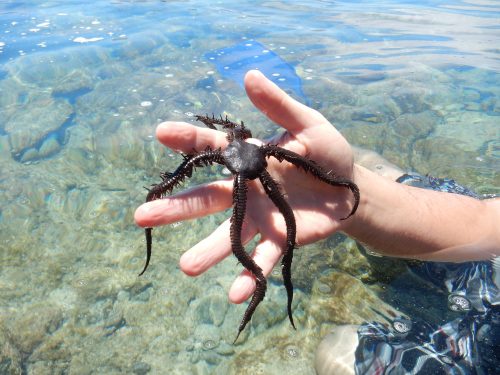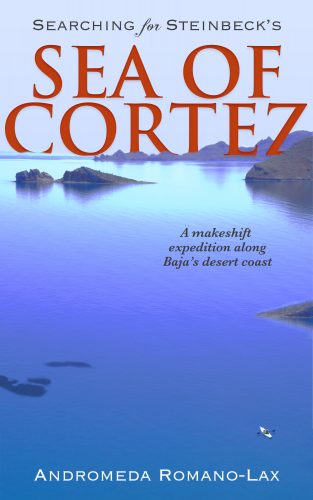 This spring, seventy-eight years ago, author John Steinbeck and his biologist friend Ed Ricketts explored the Baja coastline and its fertile tidepools, a stubbornly quirky project that he expected to be of little interest to the public. The result was his classic “The Log from the Sea of Cortez.” In 2000, journalist Andromeda Romano-Lax and her young family re-created that trip by sea and road. Her account was published in 2002 as “Searching for Steinbeck’s Sea of Cortez.”
This spring, seventy-eight years ago, author John Steinbeck and his biologist friend Ed Ricketts explored the Baja coastline and its fertile tidepools, a stubbornly quirky project that he expected to be of little interest to the public. The result was his classic “The Log from the Sea of Cortez.” In 2000, journalist Andromeda Romano-Lax and her young family re-created that trip by sea and road. Her account was published in 2002 as “Searching for Steinbeck’s Sea of Cortez.”
Available for the first time in e-book format, Romano-Lax’s re-issued travelogue mixes the joys and perils of traveling with children aboard a cramped sailboat, natural history and environmental reportage, as well as investigative biography, revealing facts about the original expedition that John Steinbeck chose to leave out. Booklist called it “a captivating guide to an extraordinary place.”
Below is a condensed excerpt.
The 1940 Steinbeck and Ricketts expedition was a marine organism collecting trip. But it was much more than that, and the hybrid Log is not just a book of science but a book of observation, escapade, and the kind of half-brilliant, half-addled philosophy that long days at sea, plus lots of Carta Blanca beer, sometimes inspire.
In Europe, bombs were falling. On Monterey’s Cannery Row, the sardine plants still whistled, and America had not yet entered the world war. But other forms of hatred filled the void. Steinbeck had received the first of many death threats for The Grapes of Wrath, a controversial best-seller that would earn him a Pulitzer Prize and a reputation as an atheistic, communist rabble-rouser. In his lifetime, he would see his writings publicly burned.
Writing The Grapes of Wrath and enduring its subsequent notoriety drained Steinbeck. He wanted a break from writing fiction. He wrote to his friend Carlton Sheffield, “I’ve worked the novel—I know it as far as I can take it. I never did think much of it—a clumsy vehicle at best. And I don’t know the form of the new but I know there is a new which will be adequate and shaped by my new thinking. Anyway, there is a picture of my confusion.”
Steinbeck longed to hide away—from the war he knew was coming, from politics and literary criticism, and from his own marriage troubles. The Sea of Cortez, an eight-hundred-mile-long gulf bordered by mostly unpeopled desert, was the perfect place to hide.
Ricketts also knew a thing or two about escape. The need to flee a romantic entanglement, a recurring theme in his life, once prompted him to tramp solo through Indiana, Kentucky, and Georgia. But this time around, Ed wasn’t running. Unlike Steinbeck, he wasn’t desperate or haunted. In fact, in 1940, Ricketts was in his intellectual and emotional prime.

A brittlestar from Isla Danzante: just one of hundreds of marine invertebrates sought by Steinbeck and Ricketts in the diverse Sea of Cortez tidepools.
They cruised south in a sardine seiner, assisted by Sicilian-American deckhands who were more interested in Baja’s whorehouses than in its flora and fauna. Ricketts kept a journal of their scientific findings and recorded many colorful trip anecdotes. Steinbeck—hard to believe—kept no journal at all.
When it came time to commit the travelogue to paper, Steinbeck included many of his own memories, insights, and flashes of humor. Despite the use of a narrative “We,” his voice is so strong in the Log that for years reviewers believed it was his book alone, a misconception that still lingers because modern paperback editions trumpet him as the primary author. In fact, Steinbeck relied heavily on Rickett’s trip journal, importing entire thoughts, stories, and one long lecture nearly verbatim. Ricketts was thrilled. “It’s so damn beautiful…,” he wrote a girlfriend after reading the first parts of an early draft. “He takes my words and gives them a little twist, and puts in some of his own beauty of concept and expression and the whole thing is so lovely you can’t stand it.”
Sometimes, Steinbeck and Ricketts agreed so seamlessly that they couldn’t remember who initiated a given thought. More often, they traded ideas without truly understanding each other’s finest points. They both adored Bach, and their late-night rambles often resembled counterpoint in classical music: two parallel motifs on a common theme, weaving but never blending.
Yet other times, as when he penned the Log, Steinbeck seemed to enjoy disappearing into his friend’s ideas, even when they conflicted with his own. It was like diving into the deep, dark waters of another’s mind. The challenge was to make it look easy: to dive smoothly, and leave no ripples.
*
John had always been a little uncomfortable in his own skin. Success, which had come to him only in the previous five years, helped him stand up straighter. But he still ducked behind his companions when a newspaper photographer appeared to see the Western Flyer shove off. Steinbeck’s voice was husky. His laugh was a low rumble. He dressed sloppily in jeans or baggy corduroys, old sweaters, and a sheepskin coat. In Baja, he’d wear a horizontally striped shirt—almost a parody of the natty nautical look—that matched the shirt his wife often wore.

The author and her daughter, fifteen years after the Romano-Lax family’s original 2000 expedition. Photo taken on Isla Carmen.
Aah, the wife. Carol. Just the mention of her name made the crew raise their eyebrows in mock alarm. One of them—Tiny or Sparky or Tex—whistled through his clenched teeth. Captain Tony Berry shot back a stern look. Carol was coming on the trip––they were all surprised to hear it––but there was nothing that could be done. At least we’ll have someone to do the cooking, Sparky said. But he was dubious. Carol hadn’t warmed to any of the crew. Even around Steinbeck, she appeared aloof. Though she had promised to keep the crew well fed with chicken cacciatore and fresh-baked bread, those meals never materialized. Sparky was named galley chef in her place, leaving Carol with no defined role on the Western Flyer.
No one could know this yet, of course, but Carol would not be mentioned in The Log from the Sea of Cortez. Her presence would be excised from the travel narrative, her entire silhouette snipped out, the mysterious hole in a post-divorce photograph. Steinbeck would cut her out so cleanly that very few readers would ever notice that something or someone is missing. “It’s okay to lie to others,” Steinbeck told Ricketts on more than one occasion. “Just as long as you don’t lie to yourself.” But it’s hard to do one without the other. The memories make the story. The story reshapes the memories.

